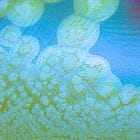Israel Engineers Mutant Plague—Puts Its Genes in mRNA Shot That Makes Human Cells Produce Virulence and Immune-Evasion 'Black Death' Proteins: Journal 'Advanced Science'

In a deeply troubling development, Israeli military scientists have genetically modified one of the deadliest bioweapons known to man—Yersinia pestis, the bacterium that causes pneumonic plague—and then used its altered genetic material to engineer a new mRNA vaccine that programs human cells to manufacture plague proteins tied to virulence and immune system evasion.
This follows the U.S. military’s genetic engineering of plague DNA into E. coli using CRISPR—a move detailed in a peer-reviewed study just weeks before the World Health Organization added the plague-caused Black Death to its official pandemic watchlist, raising fresh concerns over bioweapons development.
Unlike the U.S., China, and Russia, Israel has never ratified the Biological Weapons Convention—meaning its military bioengineering of the plague bacterium and insertion of its virulence genes into an mRNA shot occurs outside the binding framework of international bioweapons law.
The United States provides Israel with approximately $3.8 billion in military aid annually under a memorandum of understanding (MOU) that extends through 2028.
Nearly all current U.S. aid to Israel is for military purposes, delivered primarily as grants through the Foreign Military Financing (FMF) program.
Follow us on Instagram @realjonfleetwood & Twitter/X @JonMFleetwood.
If you value this reporting, consider upgrading to a paid subscription.
A peer-reviewed study published in April in Advanced Science outlines how researchers at Israel’s Institute for Biological Research (IIBR) deleted a critical gene called ‘caf1’ from a fully virulent plague strain (Kimberley53), creating a new mutant form of Y. pestis that lacks the immune-shielding capsule.
The modified bacterium, referred to as the F1⁻ strain, was used to simulate a vaccine-escape scenario and test how well mRNA vaccination would protect against engineered threats.
“Construction of the F1⁻ Kimberley53 mutant was performed by replacing part of the caf1 gene coding sequence with a linear fragment containing the KanR resistance cassette,” the researchers confirm.
Once the team had genetically altered the plague, they then used plague gene segments to build the core of a new mRNA vaccine.
The vaccine contains two synthetic mRNA sequences—each derived from plague virulence genes—which instruct human cells to manufacture modified versions of:
LcrV, a protein that enhances Y. pestis’ ability to suppress immune responses and bind to human cells via its Type III secretion system;
F1, a capsule-forming protein that helps the plague bacterium avoid detection and destruction by the host immune system.
These plague proteins were further altered by fusing them to the human Fc (antibody) domain to enhance their immunogenicity, half-life, and cellular distribution.
This resulted in a vaccine that forces the body to produce two genetically modified plague proteins, one that mimics the bacteria’s attack mechanism, and one that mimics its defensive shield.
m1Ψ: The Synthetic mRNA Ingredient Linked to Autoimmunity & Cancer GrowthAll mRNA used was chemically altered with the synthetic base N1-methyl-pseudouridine (m1Ψ), a synthetic nucleotide associated with immune evasion and prolonged protein expression—features already raising alarm in COVID-19 vaccine research.
A Cambridge University–led study published in Nature found that roughly one-third of mRNA COVID jab recipients produce unintended “rogue” proteins due to frameshifting errors caused by m1Ψ—prompting the immune system to attack the body’s own cells, a mechanism that could contribute to autoimmune disorders.
A peer-reviewed study in the International Journal of Biological Macromolecules found that the mRNA COVID shot ingredient m1Ψ significantly stimulates cancer growth and metastasis, with authors warning that COVID mRNA shots may aid tumor progression and immune suppression, especially in those receiving multiple booster doses.
Biodefense or Biowarfare? Israel’s Engineered Plague Vaccine Sparks Bioethics AlarmThe new Israeli project was conducted under the banner of pandemic preparedness and biodefense, supported by the European Research Council and the Horizon 2020 EXPERT program, with direct involvement from IIBR—a facility widely known for its military research and bioweapons development.
These experiments—because they involved genetically modifying a Tier 1 bioweapon (Y. pestis) and expressing its virulence genes in mammalian systems—were legally required to comply with strict international treaties like the Biological Weapons Convention and national biosafety laws, under high-level oversight and with full ethical and regulatory approval.
The implications are staggering.
A nation-state laboratory:
Engineered a mutant version of the plague,
Used its virulence genes to create an mRNA platform,
Instructed human biology to manufacture bacterial proteins originally evolved to attack and evade the immune system.
And they did it with full regulatory approval and peer-reviewed endorsement.
As global agencies push for rapid vaccine platforms capable of responding to biothreats, the normalization of genetically engineering Tier 1 biowarfare agents and incorporating their components into vaccines raises urgent ethical, safety, and geopolitical questions.
Under the guise of pandemic preparedness, Israeli scientists have genetically modified the plague—one of the deadliest pathogens known to man—and used its altered bioweapon genes to create an mRNA vaccine that forces the human body to manufacture proteins designed by nature to suppress immunity and evade immune destruction, all while global research confirms that the same mRNA platform risks triggering autoimmune disease and accelerating cancer.
Follow us on Instagram @realjonfleetwood & Twitter/X @JonMFleetwood.
If you value this reporting, consider upgrading to a paid subscription.
For advertising & sponsorship opportunities reaching 230,000+ monthly viewers, contact us by clicking below.
 Roughly 1/3rd of mRNA COVID-19 Vaccine Recipients Experience 'Unintended Immune Response in the Body' Caused by 'Frameshifting': Cambridge University, Journal 'Nature'Jon Fleetwood·December 8, 2023Read full story
Roughly 1/3rd of mRNA COVID-19 Vaccine Recipients Experience 'Unintended Immune Response in the Body' Caused by 'Frameshifting': Cambridge University, Journal 'Nature'Jon Fleetwood·December 8, 2023Read full story mRNA COVID Jab Ingredient N1-Methyl-Pseudouridine (m1Ψ) 'Stimulated Cancer Growth and Metastasis': 'International Journal of Biological Macromolecules'Jon Fleetwood·April 18, 2024Read full story
mRNA COVID Jab Ingredient N1-Methyl-Pseudouridine (m1Ψ) 'Stimulated Cancer Growth and Metastasis': 'International Journal of Biological Macromolecules'Jon Fleetwood·April 18, 2024Read full story After U.S. Military 'Genetically Engineers' Plague DNA Into E. Coli Bacteria, WHO Adds Black Death to New Pandemic Watchlist, Raising 'Bioweapon' Concerns: Journal 'Access Microbiology'Jon Fleetwood·August 14, 2024Read full story
After U.S. Military 'Genetically Engineers' Plague DNA Into E. Coli Bacteria, WHO Adds Black Death to New Pandemic Watchlist, Raising 'Bioweapon' Concerns: Journal 'Access Microbiology'Jon Fleetwood·August 14, 2024Read full story India Engineers Botulinum Neurotoxin Binding Domain to Target Human Nerves: 'Journal of Food Composition and Analysis'Jon Fleetwood·Jul 15Read full story
India Engineers Botulinum Neurotoxin Binding Domain to Target Human Nerves: 'Journal of Food Composition and Analysis'Jon Fleetwood·Jul 15Read full story